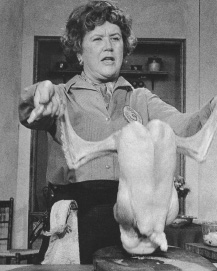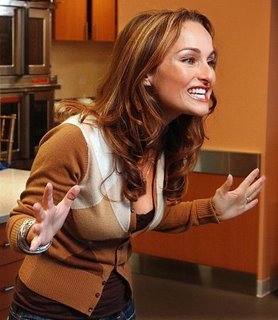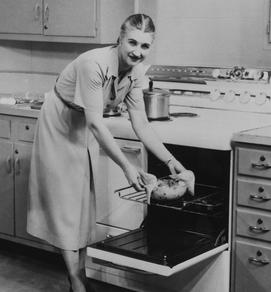TV Cooking Shows: The Evolution of a Genre
Kathleen Collins / John Jay College, CUNY

Television cooking shows are as old as the medium itself. How is it that the genre has withstood the sharp elbows of airwave competition for over sixty years, especially given their former association with dull, prescriptive women’s programming? Despite the inherent artificiality and non-biological character of the particular entity of television cooking shows, the answer to their continued existence lies in the laws of nature. One can periodize televised cooking shows as falling into the Early (1946-1962), Middle (1963-1992), or Modern (1993-present) eras. What follows are some of the major tenets of the biological theory of evolution applied to the genre of TV cooking programs from the Early Period to the present.1
In the Early Period of television broadcasting, the landscape was rapidly populated with locally produced homemaking shows hosted by prim home economists and righteous nutritionists. These shows exhibited traits inherited practically wholesale from their radio progenitors. In the Modern Period, however, reproduction has become a central concept of television programming.
For example, Ruth Lockwood, the producer of the groundbreaking “The French Chef” subsequently created “Joyce Chen Cooks” whose host was the first of many to be dubbed “the [ethnicity/nationality] Julia Child.” Chen, “the Chinese Julia Child,” even used the same set as her predecessor. A Modern Period example looks at “Food 911,” wherein beefcake chef Tyler Florence visited helpless damsels in their suburban homes when they were unable to figure out how to make pot roast before husband got home. Nearly a decade later – with no extinction of “Food 911” in sight – chef Danny Boome hosts “Rescue Chef” wherein the hottie chef is prevailed upon to visit home cooks and help them avoid cruel casserole criticism from their predatory families. Other examples include the interbreeding of Julia Child and Jacques Pepin resulting in “Julia and Jacques: Cooking at Home”; “Iron Chef” spawning “Iron Chef America”; and the multiple gene expressions of celebrity chefs like Emeril Lagasse, Nigella Lawson, Bobby Flay, Jamie Oliver, and the most fecund of all, Rachael Ray.

In the Early Period, individual members of the species were virtually indistinguishable to the naked eye (see first image). Throughout the period, however, mass consumption of processed foods and the exposure to harmful chemicals caused mutations in some pockets of the population. “Can Opener Queen” Poppy Cannon appeared on various television shows touting the wonders of using canned cream soups as the base for almost any dish. The Modern Period sees her direct descendant in “Semi-Homemade Cooking” host Sandra Lee.
Most Early Period programs died out because their producers were not yet aware of the importance of personality and “entertainment values.” As television producers and audiences became more savvy and choosy, only the fittest (watchable) survived. The theory of natural selection holds that organisms produce more offspring than can survive. This is illustrated not only by the number of cooking shows that come and go overall in the Modern Period but also on a micro level. Rapid reproduction of competition-style cooking shows is centered on the very notion of survival of the fittest. Those with harmful (e.g. “bitchy” or “cry-baby”) traits are eliminated one by excruciating one. While many of the contestants are competing for a post to run a restaurant, others are hoping to host their own cooking show. Because the Food Network ecosystem could not possibly support them all, the producers cleverly arranged for a controlled natural selection contest in “The Next Food Network Star.”
In accordance with “entertainment values,” producers in the Middle and Modern Periods introduced auspicious changes: “Galloping Gourmet” Graham Kerr pioneered the in-studio audience. Justin Wilson (“the Cajun Julia Child”) possessed a highly imitable accent. Sara Moulton offered a call-in feature. Emeril Lagasse boasted an in-studio band and an exclamatory catch phrase (“bam!”). “The Two Fat Ladies'” motorcycle with sidecar, Martha Stewart’s enviable kitchen and Giada Delaurentiis’ mesmerizing decolletage all proved favorable for the genre’s virility.

In the Early and Middle periods, cooking shows were essentially recipe instruction shows. The Modern Period saw the emergence of a new species: the out-of-studio food show. Chef-author Anthony Bourdain’s adventure-travel show “Cook’s Tour” started on the Food Network. But over time, Bourdain drifted too far off the continent for the likes of the Network brass who felt that their constituents weren’t so good at using maps. He eventually migrated to the Travel Channel where he was free to roam Asia and Africa in search of spiky and malodorous edibles. A couple of years after Bourdain’s “No Reservations,” Andrew Zimmern emerged with “Bizarre Foods” which likewise involved consuming things like jiggling brains in far-flung places. The two hosts live in harmony on their new island and occasionally appear together enjoying semi-deadly foods.
[youtube]http://www.youtube.com/watch?v=RXucin9iIaE[/youtube]
Without being schooled on the history of the genre, the average person could be excused for assuming that Julia Child was the common ancestor of the modern species. However, the first member of the species was James Beard who extolled the gastronomic pleasures of food in “Elsie Presents James Beard in ‘I Love to Eat!” The following year, Dione Lucas appeared, fixing to teach fancy French cooking to housewives. The inhospitable mindset of the Early Period – food is sustenance and cooking is a chore — did not allow Beard and Lucas to thrive. In 2005, researchers discovered that hidden genetic information unexpectedly reappears in later generations.2 A National Science Foundation press release stated, “Lolle and Pruitt postulate that the “lost” genetic information securely resides outside the standard genome and is only retrieved under particular circumstances when it may be beneficial to restore genomic sequences back to an ancestral state.”3 This may explain why in the Middle Period, the Beard/Lucas gene reappeared, expressed in Julia Child, Graham Kerr and a host of offspring. Two advantageous conditions were at last present: the widespread adoption of television values and interest in food as cultural capital and a form of self-expression. As Frank Bruni wrote of Bravo’s competition cooking show, “Top Chef,” “Its narrative arc and razzmatazz editing may take it a long way from Julia Child’s ‘The French Chef’ and the beginnings of food television, but it’s a recognizable member of the same family.”4 Bruni clearly grasps the scientific underpinnings at work in this genre.

Image Credits:
1. Cooking with Experts, Kaufman, William Irving. New York: Random House, 1955.
2. Julia Child, paradigmatic television cook of the Middle Period
3. Giada de Laurentiis exemplifies the virility of the Modern Period
4. Author’s Own Collection; Even though Early Period host is not exhibiting erect posture of Modern Period host, this attribute should not be overdetermined.
- For the sake of convenience, I have used as my source the main
Wikipedia entry on evolution. [↩] - Lolle, Susan J. et al. “Genome-wide non-mendelian inheritance of extra-genomic information in Arabidopsis.” Nature. 434.7032. 2005: 505-509. [↩]
- National Science Foundation Press Release, March 23, 2005, “Reappearance of Missing Genetic Information Poses Exception to the Rule.” [↩]
- Bruni, Frank. “Cooking Under Pressure, That’s Reality.” New York
Times 31 Jan. 2007: F1 [↩]
Very nice examination of the cooking show genre. What continues to linger (with some exceptions) between the two eras detailed here is the notion that female cooking show hosts are most televisually acceptable when cooking food for families in kitchens that are either their own in reality (such as Paula Deen) or kitchens that appear to be their own (de Laurentiis and others). Men, on the other hand, get to travel the world (Bourdain) or cook in what appear to be elaborate industrial or restaurant kitchens (Lagasse). Men cook for fun and profit (or barbecue), women for family sustenance. The Food Network has made its living on these sorts of gendered divisions — Deen and Ray being the most visible examples of the lingering insistence on patriarchal cooking ideologies. Kat Cora, the highly advertised “first female Iron Chef” on the Food Network, might be a radical break from this sort of thinking.
I wonder, what of the subgenre of cooking shows focused more on expertise? How does the manner in which the information is presented impact the genre? David Rosengarten and Alton Brown spring to mind — men who treat cooking more as an exact science than a way to feed the family. Are there analagous women cooks? America’s Test Kitchen on PBS (the TV version of Cooks’ Illustrated) strikes a nice balance between scientific and pragmatic explanations, and offers male and female chefs. However, it’s on PBS. Is anyone watching?
I can’t help thinking about Food Network’s Next Food Network Star competition and series. It really shows that they aren’t just looking for someone with culinary experience per se, but someone who will attract the right audience.
Some good academic sources on this topic that I found while writing my chapters for various books on the subject:
Chan, Andrew. (2003). “‘La grande bouffe’: Cooking Shows as Pornography.” Gastronomica: The Journal of Food and Culture 3, no. 4: 46-53.
Foster, Nicola. “Jaffrey, Madhur (1933- ): British Actor, Television Personality, Cookery Host.” Museum of Broadcast Communications Encyclopedia of Television, 2nd ed. Ed. Horace Newcomb. New York: Fitzroy Dearborn. 1204-206.
Kackman, Michael. (2004). “Cooking Shows.” Museum of Broadcast Communications Encyclopedia of Television, 2nd ed. Ed. Horace Newcomb. New York: Fitzroy Dearborn. 584-85.
Ketchum, Cheri. (2005). “The Essence of Cooking Shows: How the Food Network Constructs Consumer Fantasies.” Journal of Communication Inquiry 29, no. 3: 217-34.
Mannur, Anita. (2005). “Model Minorities Can Cook: Fusion Cuisine in Asian America.” East Main Street: Asian American Popular Culture. Ed. Shilpa Davé, LeiLani Nishime, and Tasha G. Oren. New York: New York University Press. 72-94.
Strange, Niki. (1998). “Perform, Educate, Entertain: Ingredients of the Cookery Programme Genre.” The Television Studies Book. Ed. Christine Geraghty and David Lusted. London: Arnold. 301-12.
Negra, Diane. (2002). “Ethnic Food Fetishism, Whiteness, and Nostalgia in Film and Television.” Velvet Light Trap 50: 62-76.
Toby Miller was too modest to include his own influential work on this topic, esp. the chapter “Television food: from Brahmin Julia to working-class Emeril in:
Miller, T. (2007). Cultural citizenship: cosmopolitanism, consumerism, and television in a neoliberal age. Philadelphia: Temple University Press.
Thank you, Toby!
Who is the lady shown in the “early period host” picture? I remember watching this program in my childhood. She had an assistant named “Louise” who did a lot of her fetch-and-carry work. It was on in the 50’s or 60’s.
The Early Period lady is Florence Hanford from Philadelphia. She passed away this past summer:
http://www.philly.com/inquirer.....shows.html
I wonder if you might know about a cooking show I watched in the early to mid 50s in Toledo, Ohio. In my memory I see an older woman who now reminds me of Ladybird Johnson and her assistant was an African American gentleman who did not speak.
Sandra- In he 1950s there was Dorothy Coon from WSPD-TV’s “Home Cooking” and Betty Syx in Columbus who hosted “Six is Cookin’ Show.” Maybe one of those rings a bell? -Kathleen
We are “Organic Living with the Hippy Gourmet” a national PBS and syndicated commercial television cooking series in our 10th season and reaching over 34 million homes each week. Our series features all things organic, sustainable, planet-friendly and delicious. We travel around the globe highlighting stories about individuals and organizations making a difference for a better world and visit with the great chefs who prepare fantastic recipes.
Our “Hippy Gourmet’s Quick and Simple Cookbook for Healthy Eating” (Wellness Central) is a best seller for international flavors, and millions of viewers enjoy our TV series on PBS, Dish Network 9415 (FSTV), Comcast On-Demand, Granite Broadcasting and via a direct partnership with Google and YouTube – http://www.YouTube.com/HippyGourmet
Thus, we view ourselves as the future of cooking shows on TV – well traveled, emphasizing eco-tourism to organic, sustainable family farms and cooking up recipes that are healthy and fun for the whole family.
The hosts of cooking shows in the Early Period were women most of the time, considering that during the 1950’s women’s roles as housewives included the task of cooking meals for the family.
Today, cooking shows have ventured out to have male hosts. And these male hosts are accepted as normal in today’s ideology.
I believe that this acceptance of a male as the host of a “food/cooking show” is a reflection of US movements, such as the Civil Rights movements, the Feminist movements, and the Queer movements. All these movements took conventional norms in society and questioned them. Although these movements are not over and have not achieved “full freedom of the oppressed,” little by little those in movements have earned attention and are continuously normalizing their beliefs and identities in American society. As a result, we have reorganized our roles of what women and men should/should not be and do. And as a result of this, food/cooking shows and audiences alike have reorganized their ideas of who can be a host.
I also think that “movements” in America allowed food to change its cultural meaning. Today food is not only seen as a woman’s task for the family (I believe that women are still very much attached to their roles as persons in the kitchen, but not as strict as the 1950’s.) but on the Food Network, I see food embraced as “cultural capital and a form of self-expression”(Collins). This representation of food has made the preparation of food not strictly just for “wives” who historically used food as a way to take care of the family. In today’s Modern Period of cooking shows, food is sometimes a tool for both males and females who use it as a form of expression, both artistically and economically.
Interesting chronicle…but what about the tv show “Kit in the Kitchen” I believe was on NBC and was the first cooking show. It featured Katherine (Snell) Sigety. She was a mother of 5 who was asked by her neighbour, a producer at the network, do the new concept show . It was live so there is only film with no audio that has been found. Kathine Sigety is alive and well and continues to be a leader among the women in our family. Just thought you would like to add this to your chronicle as it was the index show!
As a recent convert to the cooking show genre,I was delighted to come across this article; much enjoyed it (and the comments). I was especially struck by the section on the Social Darwinism that underscores many of the recent competitive cooking shows (Hell’s Kitchen, Top Chef, Chopped, etc.)
Just to add, the early cooking show format is instruction-based. The chef (be it Julia Child or Rachael Ray)explains the recipie, the dish is prepared step by step, and direct adress to the camera by the chef encourages viewers to “try this at home.” The modern cooking show format — such as Top Chef shows (the series I’m most familar with) — is competition-based. The chefs explain what they are making but not how to make it, the emphasis is on high-pressure kitchen production, and direct address to the camera by the chef is a means one chef can criticize another chef’s food and/or technique.
In this way, the early cooking show format demystifies and even democratizes cooking as far the chef imparting “knowledge” to educate viewers (the problematic of the recurring theme being how to make “common” food with more “class” I’ll leave open to debate). The competition cooking show mystifies cooking around elite chefs — those with superior skill and “secret recipies” — as they fight each other to get ahead. The view is reduced to a passive spectator rather than a potential participant in the cooking experience.
Pingback: Cookery Show | PEEPING TOM
My mother cooked on tv during the mid to late 1950s with the Philadelphia Gas Works. Do you have any links that I can use to read about this? I have some of my mother’s ‘ scripts’ or ‘scheduled on air recipes’ she was to prepare. The Gas Works does not have much info or anything listed about that aspect of their company on their website. My mother’s name – Jeanne Holden. She passed away in 2007.
Pingback: The Most Famous Cooks You’ve Never Heard Of – Rachel Laudan
I remember a cooking show from the Fifties. I think it was called “The Bontempis”. The wife did the cooking and the husband played with the dog and sang an opera aria. I could not find anything on the Internet about them. In your research did you find them? It \The program was broadcast in the NYC metro area.
Thank you.
what was the name of the the guy on the lady of charm cooking show
My Grandmother was on a local cooking show in the 1950’s here in Tacoma WA. She was the woman behind the man, doing the work while he talked. I don’t know where to start looking to find any video that may still exist. Can anyone give me advice? Unfortunately I don’t have much information – although on the day of her funeral King 5 in Seattle was celebrating their anniversary and showed a brief clip of her.
Now one can get some discount on Donuts by taking Tell Dunkin survey.